#History of Mandalore
Text
History Of Mandalore
Finally got around to getting those better pictures I promised!, So here they are!
For a full transcription of them, here's the link to my old post.
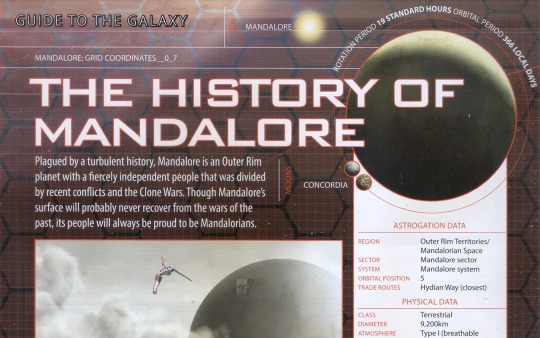

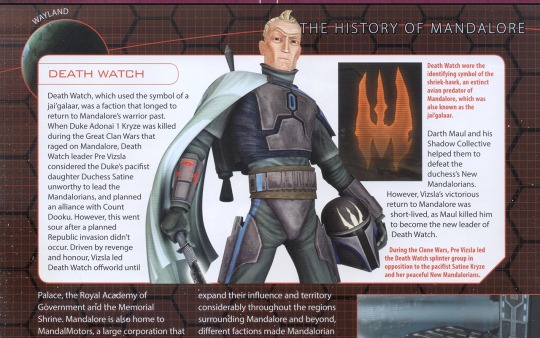
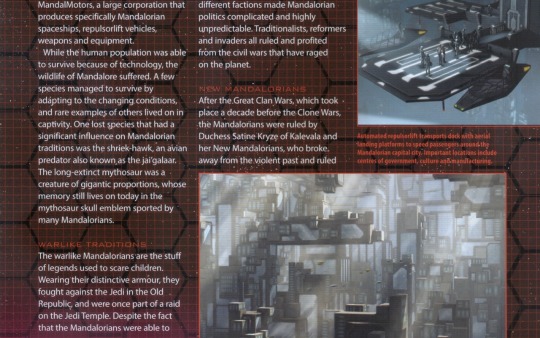
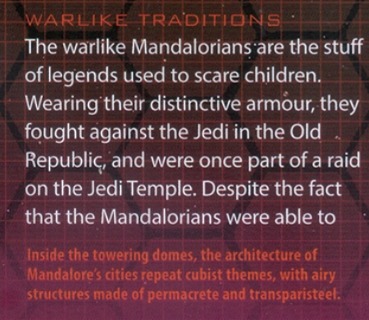


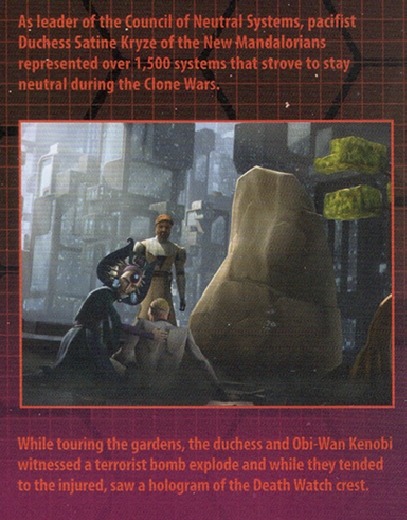
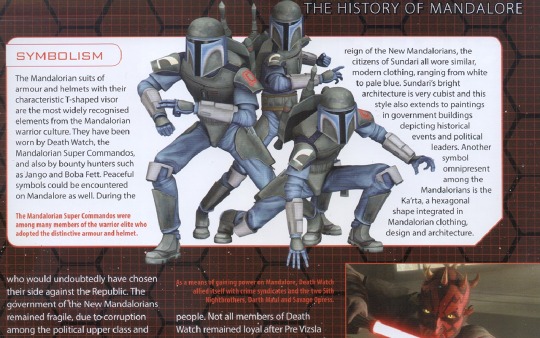
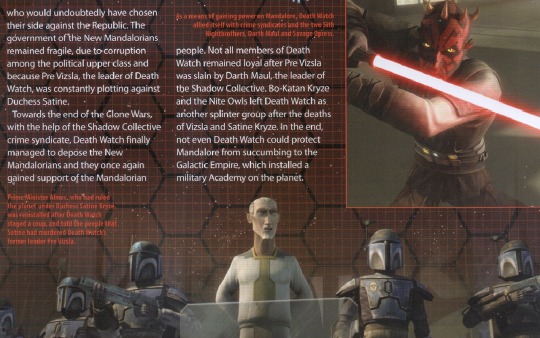
10 notes
·
View notes
Text
History Of Mandalore
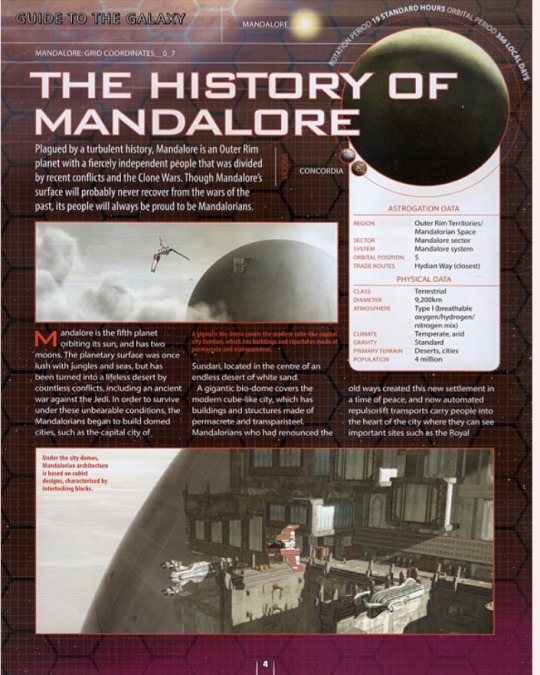


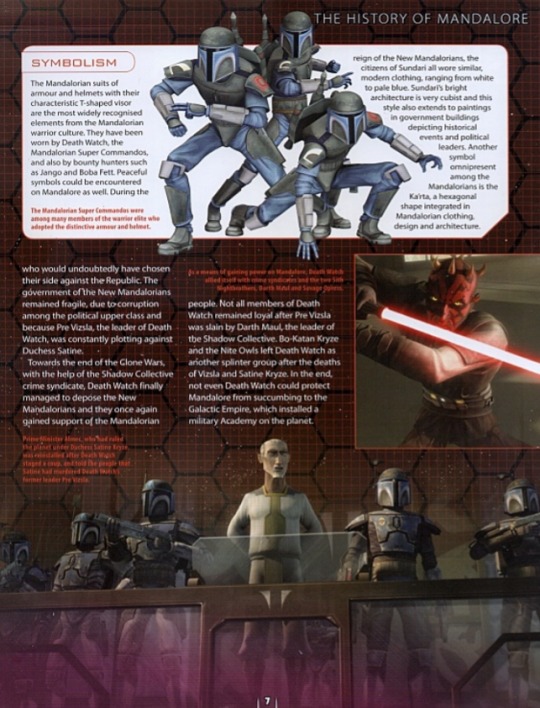
Build the Millennium Falcon: Guide to the Galaxy - The History of Mandalore
Sorry for the quality of the images, but it was the best ones I had
Text on the images is written down for those whose image isn't loading or simply find the quality of the images too hard to read, after the break.
I will handle first the actual text, then Death Watch and Symbolism, and finally the Behind the Scenes text. All the red (and yellow) texts will appear between two brackets at the end of the section that they appeared in.
(Mandalore: Grid Coordinates_0.7
Rotation period 19 Standard Hours, Orbital Period 366 local days; Moons: Concordia;
Astrogation Data:
Region - Outer Rim Territories/Mandalorian Space
Sector - Mandalore Sector
System - Mandalore System
Orbital Position - 5
Trade Routes - Hydian Way (closest)
Physical Data
Class - Terrestrial
Diameter - 9,200 km
Atmosphere - Type I (breathable oxygen/hydrogen/nitrogen mix)
Climate - Temperate, arid
Gravity - Standard
Primary Terrain - Deserts, cities
Population - 4 million
HISTORY OF MANDALORE:
Plagued by a turbulent history, Mandalore is an Outer Rim planet with a fiercely independent people that was divided by recent conflicts and the Clone Wars. Tough Mandalore's surface will probably never recover from the wars of the past, its people will always be proud to be Mandalorians.
Mandalore is the fifth planet orbiting its sun, and has two moons. The planetary surface was once lush with jungles and seas, but has been turned into a lifeless desert by countless conflicts, including an ancient war against the Jedi. In order to survive under these unbearable conditions, the Mandalorians began to build domed cities, such as the capital of Sundari, located in the centre of an endless desert of white sand.
A gigantic bio-dome covers the modern cube-like city, which has buildings and structures made of permacrete and transparisteel. Mandalorians who had renounced the old ways created this new settlement in a time of peace, and now automated repulsorlift transports carry people into the heart of the city where they can see important sites such as the Royal Palace, the Royal Academy of Government and the Memorial Shrine. Mandalore is also home to MandalMotors, a large corporation that produces specifically Mandalorian spaceships, repulsorlift vehicles, weapons and equipment.
While the human population was able to survive because of technology, the wildlife of Mandalore suffered. A few species managed to survive by adapting to the changing conditions, and rare examples of others lived on in captivity. One lost species that had significant influence on Mandalorian traditions was the shriek-hawk, an avian predator also known as the jai'galaar. The long extinct mythosaur was a creature of gigantic proportions, whose memory still lives on today in the mythosaur skull emblem sported by many Mandalorians.
[A giantic bio-dome covers the modern cube-like capital city Sundari, which has buildings and structures made of permacrete and transparisteel.
Under the city domes, Mandalorian architecture is based on cubist designs, characterized by interlocking blocks.]
Warlike Traditions
The warlike Mandalorians are the stuff of legends used to scare children. Wearing their distinctive armour, they fought against the Jedi in the Old Republic, and were once part of a raid on the Jedi Temple. Despite the fact that the Mandalorians were able to expand their influence and territory considerably throughout the regions surrounding Mandalore and beyond, different factions made Mandalorian politics complicated and highly unpredictable. Traditionalists, reformers and invaders all ruled and profited from the civil wars that have raged on the planet.
[Inside the towering domes, the architecture of Mandalore's cities repeat cubist themes, with airy structures made of permacrete and transparisteel.]
New Mandalorians
After the Great Clan Wars, which took place a decade before the Clone Wars, the Mandalorians were ruled by Duchess Satine Kryze of Kalevala and her New Mandalorians, who broke away from the violent past and ruled Mandalore through peace and diplomacy. As leader of the Council of Neutral Systems, the duchess represented over 1,500 systems that strove to stay neutral during the Clone Wars. Satine ruled with the assistance of a Prime Minister and a Ruling Council of at least six Ministers, among them a Minister of Finance and a Minister of the Interior. Other functions in the government were those of the Governor and Deputy Minister.
The New Mandalorians struggled to minimise the influence of the group known as Death Watch, who longed to return Mandalore to its warrior roots with the support of the Confederacy. Secretly leading Death Watch was Governor Pre Vizsla of Concordia, one of Satine's trusted allies. Also on Death Watch's payroll was Prince Tal Merrik, the Senator of Kalevala and one of the duchess's oldest friends.
After being betrayed by her allies, Satine barely succeeded in avoiding a Republic intervention on Mandalore by uncovering a recording that showed the Republic Senate a forged message from the loyal Deputy Minister Jerec. Had that invasion taken place, Death Watchstood ready to act as the liberators of the Mandalorian people, who would undoubtedly have chosen their side against the Republic. The government of the New Mandalorians remained fragile, due to corruption among the political upper class and because Pre Vizsla, the leader of Death Watch, was constantly plotting against Duchess Satine.
Towards the end of the Clone Wars, with the help of the Shadow Collective crime syndicate, Death Watch finally managed to depose the New Mandalorains and they once again gained support of the Mandalorian people. Not all members of Death Watch remained loyal after Pre Vizsla was slain by Darth Maul, the leader of the Shadow Collective. Bo-Katan Kryze and the Nite Owls left Death Watch as another splinter group after the deaths of Vizsla and Satine Kryze. In the end, not even Death Watch could protect Mandalore from succumbing to the Galactic Empire, which installed a military Academy on the planet.
[Automated repulsorlift transport-decks with aerial landing plataforms to speed passengers around the Mandalorian capital city. Important locations include centres of government, culture and manufacturing.
As the leader of the Council of Neutral Systems, pacifist DDuchess Satine Kryze of the New Mandalorians represented over 1,500 systems that strove to stay neutral during the Clone Wars.
While touring the gardens, the duchess and Obi-Wan Kenobi witnessed a terrorist bomb explode and while they tended to the injured, saw a hologram of the Death Watch crest.
Prime Minister Almec, who had ruled the planet under Duchess Satine Kryze, was reinstalled after Death Watch staged a coupp, and told the people that Satine had murdered Death Watch's former leader Pre Vizsla.
As a means of gaining more power on Mandalore, Death Watch allied itself with crime syndicates and the two Sith Nightbrothers, Darth Maul and Savage Opress.]
Death Watch
(Wayland is a possible planet shown behind the white box of text that the Death Watch section is in.
OP here, is it possible that Wayland is the name of the second moon? Food for thought for those who are reading.)
Death Watch, which used the symbol of a jai'galaar, was a faction that longed to return to Mandalore's warrior past.
When Duke Adonai 1 was killed during the Great Clan Wars that raged on Mandalore, Death Watch leader Pre Vizsla considered the Duke's pacifist daughter Duchess Satine unworthy to lead the Mandalorians, and planned an alliance with Count Dooku. However, this went sour after a planned Republic invasion didn't occur. Driven by revenge and honour, Vizsla led Death Watch offworld until Darth Maul and his Shadow Collective helped them to defeat the duchess New Mandalorians.
However, Vizsla's victorious return to Mandalore was short-lived, as Maul killed him to become the new leader of Death Watch.
[Death Watch wore the identifying symbol of the shriek-hawk, an extinct avian predator of Mandalore, which was also known as the jai'galaar.
During the Clone Wars, Pre Vizsla led the Death Watch splinter group in opposition to the pacifist Satine Kryze and her peaceful New Mandalorians.]
Symbolism
The Mandalorian suits of armour and helmets with their characteristic T-shaped visor are the most widely recognized elements from the Mandalorian warrior culture. They have been worn by the Death Watch, the Mandalorian Supper Commandos, and also by bounty hunters such as Jango and Boba Fett. Peaceful symbols could be encountered on Mandalore as well. During the reign of the New Mandalorians, the citizens of Sundari all wore similar, modern clothing, ranging from white to pale blue. Sundari's bright architecture is very cubist and this style also extends to paintings in government buildings depicting historical events and political leaders. Another symbol omnipresent among the Mandalorians is the Ka'rta, a hexagonal shape integrated in Mandalorian clothing, design and architecture.
[The Mandalorians Super Commandos were among the many members of the warrior elute who adopted the distinctive armour and helmet.]
Behind the Scenes: Long History
The name Mandalore first appeared as a mention on the Boba Fett concept art drawn by Joe Johnson for The Empire Strikes Back, which referred to him being a 'super commando from the Mandalore system'. The name Mandalore was kept alive and appeared for the first time in Star Wars 68: The Search Begins, a Marvel comic from 1983, where Leia is searching for Han Solo, frozen in carbonite. Many aspects of the planet and its culture were created after a connection had been established between the clone troopers and the Mandalorians. Author Karen Traviss once even worked on turning Mando'a into a working language. Star Wars: The Clone Wars chose a new direction for Mandalorian society, but also kept some elements from former stories, such as Death Watch. A lot of prequel concept art was reused for the Mandalorian designs, such as a concept art that had been originally intended for Amidala (Satine) and Sith (Mandalorian Royal Guards).
[The Mandalorian Royal Guards were based on concept art originally designed for the Sith.]
#star wars#sw#mr talks#mandalorians#build the millennium falcon#guide to the galaxy#history of mandalore#text of the images under the break#satine kryze#pre vizsla#death watch#new mandalorians#mandalore
25 notes
·
View notes
Text
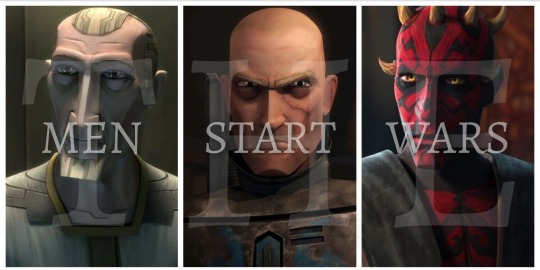

Maisie Peters, History of Man
221 notes
·
View notes
Text
Canon mandalorian art and the Murals of Sundari
There's a very interesting thing about canon mandalorian art. Outside of Sabine's graffitis and armor paint, the only canon mando figurative art (that I have found) are the statue of Tarre Vizla -which go perfectly in star wars' long tradition of dead historical figures' statues, especially for Jedi- and the three murals of Mandalore. I said figurative because there is also the Memorial Shrine on Sundari that was bombed by death watch during the clone wars that is definitely not figurative. But that's another subject.
Of those two exemples of mandalorian sculptures that we know of, we have an old, historical, imposing rendition of a past Mand'alor (and in both medium and subject, what I personally headcanon as the favored type of art by Mandalorians) and a series of murals depicting one of the victories of the Mandalorians over the Jedi, during one of their war. And that mural is the only major art we see in Sundari, the New Mandalorians' Capital.
And that's what I'm going to talk about.



Those three murals have obviously been inspired by Picasso's Guernica. I'm absolutely not a Picasso specialist nor do I wish to be (he was an asshole first category, thank you very much but ew). But. What I do know is that Guernica was commanded to Picasso to illustrate the city Guernica's bombing and denounce fascism, and later on was a symbol of the horror of the war (especially the world war 2 which started two years after the realisation of this imposing painting). The blatant difference with Guernica in those murals is that the violence isn't denounced at all. It's highlighted. The Mandalorians Crusaders have halos, they're bigger, standing, orderly, majestic. Opposed to that are the Jedi, distorted, chaotic, small, at the feet of the Mandalorians. This is obvious propaganda in favor of the victors of the battle. (Of the battle only because it's the Jedi who won that war.)
Using Guernica was an interesting and easy way to show "A War" even if the soul of it is completely reversed (which is really interesting too) but yeah, that's a smart and quick way to send a mood to the person watching those episodes of clone war, without needing to focus on the art. You see the style, you understand roughly what's the meaning of it. End of the parenthesis.
What is interesting is that this is the only figurative art I've found for the New Mandalorians. More than that, that last mural was right under the speaking balcony, above the royal platform of Sundari's palace. Satine Kryze talked about her ideals just over the graphic depiction of Jedi being decapitated. This, added to the cultural genocide the New Mandalorians were making, paint one hell of a picture.
For that last part on the New Mandalorians, @/fox-trot made an amazing explanation of it, in some of their tags once but I can't find the post again :( roughly, they were highlighting how, notably in Legends, the Mandalorians used to be a vastly diverse people, different colors of skin, different species.... But with the arrival of the New Mandalorians, not only we can't see any art but those ones, not only do they want to erase entire parts of their traditions and culture (armor doesn't mean war, you could change the warrior and blood culture without taking the armor out, cue Jedi and their weapons lightsaber), but they also are all human, white and rich. Boba and Jango Fett aren't seen as Mandalorians at all. The Wren are Death Watch so traitors and terrorists. The New Mandalorians are good and safe and refuse any way of protection, are more passive than neutral in that regard, and are a white, human elite.
That elite have hid/erased/we-can't-even-know-because-it-can-only-be-seen-in-it's-obvious-absence all of their traditional art but those murals, depicting the massacre that was one of their victorious battles in a war they ultimately lost. This is one hell of a propaganda and rewriting of History.
You can read it in many ways, two I can think of are :
-the New Mandalorians Government want to send the message "See how bloody and terrible and not-good mandalorian culture is. We need to be pacifists to not-be-like-that"
-but what it can look like is the symbolic reality of what they're doing : a cultural genocide painted in glorious light.
Anyway you want to look at it, with such a critical light of the new mandalorians or not, that those murals are the only art display in Sundari's palace still send one hell of a message.
#i know that i've been hella critical of the new mandalorians here#but i still hope it reads as the objective understanding based on facts that it is#i love satine but hell what her government did was messed up at times#anyway i hope this rambling/essay is clear and readable#i have thoughts on those murals ok ? xD#sw art and culture#mandalorian lore#mandalorian art#new mandalorians#new mandalorians critical#sw#mandalore murals#hi tumblr void#hasta rambles#about fictional art history again#pablo picasso
63 notes
·
View notes
Text
All the problems in the Mandalorian could’ve been solved if Sabine had kept the Darksaber
#that girl could use it#Gideon shows up like surrender or we’ll bomb Mandalore and she’s just like ‘nah’ and whistles for Ezra and his Purgil#she’d wipe out all the imperials in the sector with homemade bombs 1000x more effective than the empire’s and paint gorgeous murals about it#could totally see her working with Luke and Ezra to build a the New Jedi Order on Mandalore#creating a culture of the most badass light side users in galactic history#man I love writing banger fanfic ideas in the tags and never using them#star wars#Mandalorians#sabine rebels#Sabine wren#Mand’alor Sabine wren#Mand’alor Sabine#the darksaber#darksaber#the Mandalorian
319 notes
·
View notes
Text
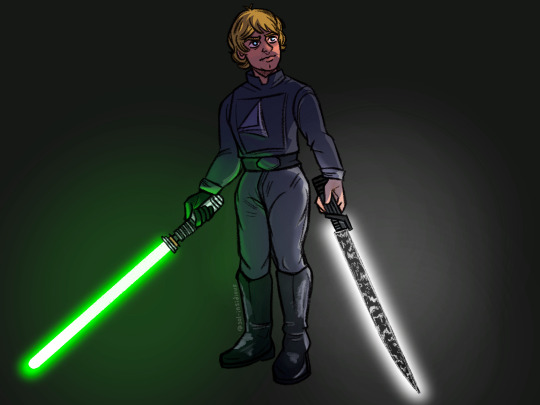
Luke weilding both his green lightsaber and the darksaber is my favorite thing in the world actually.
Close-ups below:


✨slay✨
#star wars#the mandalorian#luke skywalker#the darksaber#dinluke#(implied)#fellas is it gay to wield the ancestral weapon that defines your husband's authority over his people as the sole ruler of Mandalore#that is also the physical symbol of how your cultures intersected at one point in history then violently parted#until you two came along and were two boys who kissed#Din in the background: “oh my god please just take it”#Luke: “lmao sorry babe I already have one genocided culture to revive” *muah* “luv u” :)#sol draws the space gays
113 notes
·
View notes
Text
Justice for Fenn Shysa!
Well, that may be too strong a wording, but, seriously, Fenn Shysa deserves a lot more respect than he seems to get these days. Turns out I have a lot of thoughts and feelings on the subject, but the thing is, they're based on canon. (Legends canon, but considering how little new Disney canon ended up giving us, that still is where most Mandalorian discourse is happening to begin with.)
Fic writers (at least on AO3) who are into Mandalorians seem to love, love, love Jaster Mereel. They seem to think Jaster Mereel would have fixed everything, if only he had lived. There is an image of Jaster Mereel people have built up, and which they love, and hold up as a metric of what a good Mandalorian and Mand'alor is like.
I love it myself, but. But. Most of it is pure fanon.
Fenn Shysa's accomplishments aren't. Fenn Shysa is canonically great. Where are all the Fenn Shysa fics?!
Fenn Shysa, who incidentally has a lot in common with Jaster, actually did fix everything.
And it's a very interesting comparison to make because the two actually do have a lot in common, on a superficial level. They're both Mand'alors who started out as policemen, and don't come from a big established clan. But it seems to me that they took very different lessons from their experiences, and as far as I can see Shysa comes out the better from the comparison. Mereel, heralded as the reformer, by all appearances (including what lessons Jango seems to have taken from him) still doubled down on certain hardwired Mandalorian stock responses. Shysa moved on from them. Shysa overcame the biggest Mandalorian shortcomings.
(As far as I can see, the only thing Jaster might canonically have over him is taking in a ward (did he ever actually adopt Jango?) when Shysa remained without any family. Considering the truly hard times Shysa lived in, considering he spent a good deal of his adult years as a guerrilla fighter desperately trying to save people from the Empire, I can't find it in myself to hold it against him.)
And it's also interesting for a Mandalorian fan inclined to draw never-stated conclusions to compare them just by how they present. To look at Jaster Mereel, and look at Fenn Shysa, and see one wearing the colour of justice, and the other the colour of duty. Neither is necessarily wrong, of course, but in-universe, it probably does say something about them. We first meet Jaster fighting a civil war, bent on eliminating his opponents; we first meet Shysa freeing enslaved people. Their reasons for fighting differ considerably. And so do the results of their actions.
And it's the actions where Shysa shines. Where it's Shysa who is the real reformer.
Fenn Shysa actually united Mandalore. If you draw conclusions from the shifting canons the exact same way you do with Jaster, Fenn Shysa actually managed to work with all the factions and gain their respect: the fact that he was an undisputed Mand'alor after the fall of the Empire is Legends canon, not just fandom speculation of what the situation was and could have been.
Based purely on actual established canon events, Fenn Shysa was just about the best Mand'alor ever. Not flawless, of course, but better than most Mandalorians, able to rise above their common failings that have kept dooming them all throughout their history. He did not hold grudges, he wasn't isolationist, he wasn't inseparably married to the idea of warrior glory, while still maintaining warrior honour and a certain sort of proud independence. But he was not too proud to ask the Rebel Alliance / New Republic for help when Mandalore was attacked and overwhelmed - and not too proud to work with them. He also forgave and helped his enemies when it turned out they may have had somewhat justifiable reasons for their attempts at conquest, and immediately offered them Mandalorian help in reclaiming their own home. (Isn't one of the biggest failings of the Mando'ade how much they hold grudges, dooming any attempts at fruitful collaboration through old blood feuds and petty disagreements?) And he worked with the nascent New Republic, yet without giving in an inch of Mandalorian independence. He united the things the various factions wanted: he was an honourable warrior upholding the Supercommando Codex, he achieved peace within the system and peace with the Republic, and he gave rabid traditionalist Mandalorians actual wars to fight in which Mandalorians could prove their mettle before the Galaxy - just not destructive wars of conquest. It's not like the GFFA is short on villainous factions to try and stop.
It's Tobbi Dala who touches on it out loud in the comics, not Shysa specifically, but he obviously echoes Shysa's ideals: Their highest purpose as warriors is to protect. That's what the Resol'nare say, nothing else. Shysa started out, in the Clone Wars, as more or less a mercenary, like Jaster, but I think, outside of situations when he did have to be pragmatic about things like making a living, he outgrew it into something even greater.
Fenn Shysa may not have written a neat manifesto, but I bet he actually lived it. He was the best Mand'alor Mandalore had had in ages. Fenn Shysa was exactly the Mand'alor the Mando'ade needed, when they most needed him. He revived their spirit and their purpose after centuries of strife and defeats.
More respect for Fenn Shysa, please. Much, much more.
(I guess the unquestioning love of Jaster at Shysa's expense is excellent proof of the truth of that one Mandalorian saying: "He who writes, remains." 🙄)
#star wars#star wars eu#star wars extended universe#star wars legends#Fenn Shysa#mandalorians#mandalorian#Mand'alor Fenn Shysa#jaster mereel#Mand'alor Jaster Mereel#true mandalorians#mandalorian protectors#canon vs fanon#mando'ade#the supercommando codex#resol'nare#mandalorian culture#mandalorian history#Who is the real Mandalore the Reformer?!#meta
25 notes
·
View notes
Text
Temuera is in Hawai‘i filming Chief of War with Jason Momoa, and he’s out there bringing to life a complex part of Hawaiian history and politics, and this project will deal with all the nuance of culture and conquest and how civil war and cultural conflict change and shape our lives and how Polynesian culture endures and endures and I’m so happy for him but also he left us here alone with only David Filoni to write Mandalorian culture and I need him to come home right now because I’m so scared-
#The show hes filming#Literally covers an aspect and event in Hawaiian history that is very similar#To the mandalore civil wars#How could he leave us in our time of need#Please#Star wars
259 notes
·
View notes
Text
Satine is more like Tarre Vizsla than Pre Vizsla could ever hope to be and he knows it.
#satine kryze#tarre vizsla#pre vizsla#tarre 🤝 satine: Bringing Mandalore to it’s peak across thousands of years of history#pre knows and it makes him furious#i fully believe if satine ever got to wield the darksaber#she’d handle it better than anyone else that wasnt a jedi
17 notes
·
View notes
Text
"you know a lot about star wars"
OH YOU HAVE NO IDEA SIR. WE HAVEN'T EVEN GOTTEN ANYWHERE NEAR MY BLORBO GLUP SHITTO.
#all i did was name drop mando factions#like. you have to understand that i know a significant amount of mando'a and have spent hours on wookiepedia trying to understand din's#affiliation to death watch via children of the watch. tbh i still don't really understand what's happening there.#anyways i wouldn't say i know much about mandalore? i know basic history incl dral'haan/excision and galidraan and tarre vizsla but not much#beyond the fact that these events/people existed.#like i don't even know enough to have an actual opinion on satine#how can anyone claim to know anything about mandalore esp republic/post-empire era while not having an opinion on satine?!#interacting with Real Life Fans is always such a reality check lmao#star wars
19 notes
·
View notes
Note
Following from your tags on the Galidraan post, there's actually a canon(-ish) source that states that the Darksabre was chosen by VIZSLA as their symbol of the Mand'alor: Tor Vizsla's in-universe Ba'jurne Kyr'tsad Mando'ad, which is included at the end of the real-world book, The Bounty Hunter Code. Direct quote is: "To ensure we would be led by the most powerful, we decreed that any could challenge the Secret Mand'alor for leadership of Death Watch. And, as our symbol of authority, we chose the Darksaber, an ancient weapon liberated from the Jedi long ago." (Please ignore my editing in the image.)
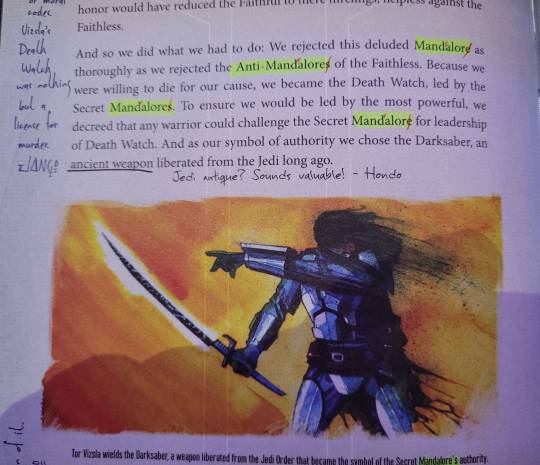
(The whole text of the Ba'jure Kyr'tsad Mando'ad is on google sites: https://sites.google.com/view/bajurne-kyrtsad-mandoad/title-page)
Yep, I have that book, it's actually a really fun reference, all the books in that series are! <3

But yup, see, this is another part where I see how Legends doesn't quite match up with current canon. The info in this book is Legends, specifically Legends as published in 2013. But in New Canon, given how the Darksaber is treated in Rebels and now in the Mandalorian, I feel like it being solely the symbol of "the Secret Mand'alor" is kinda BS—it's much more treated as the symbol of ALL of Mandalore.
Of course, one could interpret all of this through the lens that Clan Wren is part of House Vizsla so all of Sabine's story is biased (I'm still not happy they made that association...), and Bo-Katan used to serve Pre so of course she's got Vizsla bias, and Din was rescued by Death Watch + Paz is in his covert so presumably his covert also has strong Vizsla/Death Watch bias.
New canon is so incredibly Vizsla/Death-Watch centric, perhaps "Vizsla's Mand'alor" is the only Mand'alor that matters anymore. Which. Ugh. But kinda feels that way.
Anyway, while it isn't based on anything official, I do feel like if the Darksaber existed when Open Seasons was written, there might have been some more history with it there. Because keep in mind, even though they're both Legends, Open Seasons still predates the Code book by over a decade, and much of Legends isn't consistent.
My own take is that IF we go by the premise that the Darksaber is the symbol of the rightful leader of all of Mandalore and NOT just Death Watch, then it should make sense that at different points of time between the Darksaber becoming the symbol and the "present," it would have passed between different clans, especially since modern Death Watch is an extremist terrorist organization that has not been depicted as being the rightful anything tbh.
Therefore to me, the Darksaber is more interesting if it's a neutral symbol planetary leadership, which may have originated from Tarre Vizsla, someone who is not synonymous with Death Watch of the Clone Wars~onwards eras. Vizsla may claim that it's only a symbol of them and their Mand'alor, but again then that makes a distinction between that and a leader who unifies all of Mandalore.
It's more interesting if Jaster and Jango once had the Darksaber and were recognized as leaders, and perhaps that too was part of why Tor Vizsla was so determined to take them down, if he felt they were unfit to wield it. His underhanded tactics in getting rid of them would then mean that he didn't win the saber in fair combat, which means that when Pre presumably inherited it, its current presence in his family isn't rightful in the first place, and perhaps he never knew. That then leads to the question of whether any current claim to the Darksaber is legitimate if the last true wielder was taken down by Vizsla manipulating Jedi from the shadows, never lifting a finger himself. That kind of moral debate of honor, of understanding the messy past of Mandalore...that kind of juicy drama, I am all for.
To be clear, I'm biased, and none of the above is me saying "this is the right way to interpret this media." This is just how I, personally, am choosing to internalize it. I don't like Death Watch and don't think they have been depicted as honorable in ANY media they're in. It does not make any narrative sense, at least to me, to put them on a weird pedestal while stripping Boba, Jango, Jaster, and the other True Mandalorians of all historical and cultural relevance. IF the Darksaber is a symbol solely of Vizsla leadership, then I cannot imagine WHY anyone would want to make it into a cool fun symbol to build a franchise around and give to a hero character. So I'm hoping that canon will eventually lean a bit towards my personal interpretation, even though I have little faith that it will.
If it doesn't, eh, that's alright! I'm more than capable of making my own lil stories and entertaining myself!
Anyway, this response went a bit longer than I expected but yeah, those are my thoughts on the Darksaber and how I've personally chosen to combine Legends + New Canon!
❀ ❀ Send YukiPri an Ask! ❀ ❀
#batsutousai#YukiPri replies#Darksaber#the Mandalorian#Mandalorians#Mandalore#Star Wars#Star Wars Legends#Mand'alor#Death Watch#Vizsla#Jaster Mereel#longpost#long post#OP comment: btw this is the take on that history in all of my own works#at the same time who knows man i don't understand a lot of new canon decisions#like it makes zero sense to me why giving Din a symbol of the Death Watch king would be a cool thing to do#but it also makes zero sense to me why anyone in their right mind would think that giving a child the weapon of a Zygerrian slaver#and make that her iconic weapon is a good idea
89 notes
·
View notes
Text
just making it clear before mando comes out that i love bo katan and i stan women's wrongs so if ur not about that just keep it far away from me pls
#i got a weird DM from someone about how they hate bo katan like ?? number one blocked#but number two why??? shes a great character and her antagonism w din and past w her sister and w the history of mandalore is such good tv??#sorry you are confused#bo katan kryze#the mandalorian#din djarin
78 notes
·
View notes
Text
There’s only 17 days until The Mandalorian season 3! Here’s today’s prompt:
If you could ever be in The Mandalorian yourself, what role would you want to have?
#HIS WIFE#okay okay but fr#my work character background is being a galactic historian with a concentration in mandalorian history#so maybe i’ll be din’s historian for mandalore#the mandalorian
56 notes
·
View notes
Text
So here my headcanons on Bo Katan, Satine and Mandalore general (part of) story.
Bo was born 46 BBY, making her 11 years younger than Satine, when she turned 5 she took the Creed with her father looking proudly. That same year, in 41 BBY, the Civil War started. Satine, the oldest of the Kryze siblings, is put in protection of the Jedi spending a year or more in the run, the other sibling (Korkie’s parent) is sent with an adoptive family offworld as well as Bo. Their father is killed while fighting during one of the last battles and their mother ends up with a really bad injury that affects her health.
Now 39 BBY, the Kryze siblings return to Mandalore, Satine 18, the second siblings not so far from Satine’s age and Bo barely 7. Now with her father dead, her mother terribly ill, her oldest sister ruling and her other sibling trying just to make his own life while also supporting their sister, now Duchess of Mandalore (who has the homework and burden to rebuilt a fractured society), and taking care of their mother, she finds herself alone, she tries to help and to bond, and her siblings try to be good siblings to her, as well as their mother try to make her best effort to get better and still being a good mother, but most of the time it's impossible.
And then a year later, their mother dies. Living two teenage and a child orphan. Satine being an adult and the ruler can keep her siblings together with her. She tries so damn hard to be a good sister and sometimes even a parent, but of course not always works. The middle sibling goes to university and find themselves good people to share life, makes good friends, good allies etc. But Bo who's barely 8 finds that feeling of familiarity in other places, sadly she's not that lucky as her older sibling, she's taken under the wing of some uncle/close family friend, who secretly went against their father and supported the Old Mandalorians during the Great Clan Wars, and he makes her feel that family love she needs. So now 8 years old Bo Katan is constantly invaded with pretty extremist ideals. It takes years for Bo to break with her father and Satine's ideals because Satine always tried so hard to teach her siblings what their parents would have thaught them.
It's 29 BBY and Bo is 17, she and Satine get into a pretty big fight, everything comes out, Bo tells Satine everything she had learn all this years, that the New Mandalorians are not real Mandalorians and that they are just a bunch of egocentrical politicians and that they should follow the real Way of the Mandalore, embrace war and military power. Bo leaves and it's then when Satine see how her little sister has been manipulated and groomed, the years that follow are worse. When the Death Watch start acting it breaks Satine's heart every single time, to know that Bo was part of all that.
Another Civil War had break out. But now they're on different sides. Bo is part of the Death Watch and Satine's is part of the New Mandalorians. War begings to build up and she makes terrible things, she took terrible choices that ended up with her oldest sister dead. Now she sees how people she had trusted had abussed her and took everything from her, until now she wishes she could just go back in time and make everything different, but it's to late, Mandalore had suffer, they're once again broken, and they have not a ruler who would heal them again. Bo tries so much, she tries to make up everything she did, and honor her sister's memory and sacrifice, but that's not enough for when the Empire arrives and destroyed every single corner of her planet, millions of people death, completly destroyed cities. Mandalore has fallen.
#star wars#bo katan kryze#satine kryze#the mandalorian#duchess satine#mandalore#the clone wars#obi wan kenobi#padawan#Brotherhood#star wars rebels#sw rebels#this are some headcanons but i always try to get my self canon based on canon information#and since i'm not the best with Mandalorian history maybe there's quite a few of mistakes here#anyways let me know what you think#i have wanted a satinee book about her year on the run with obi wan#and i still wanted but now i also want that book to focus on her relationship with bo and to see bo pov#to get to know how did she reached the point she was during the clone wars#galactic empire
27 notes
·
View notes
Text
Sabine theory with some Ahsoka Ep 6 spoilers
Okay, one Sabine thing that I think Star Wars media (both in Rebels and now in the Ahsoka show) never really talks about is that she shouldn't be a Republic sentimentalist. But I think that it is a perfect explanation for that conversation in Ep 6 when Thrawn questions how she was willing to damn the Republic just for a chance to find Ezra.
Okay for context: Sabine was at most 2 years old when the Republic fell. She never really knew the Republic as a system, as she grew up in an Imperial controlled galaxy. Furthermore, her "education" was at the Imperial Academy of Mandalore. I doubt anything they taught her there spoke about the Republic in a positive light.
This leads to my next point. Sabine is Mandalorian. While Mandalore was nominally part of the Republic prior to the Clone Wars, under Duchess Satine's rule they were part of the Council of Neutral Systems and did not engage in the war. And even then, we know that Sabine's mother was a part of Death Watch, the splinter group that opposed the New Mandalorian's pacifist policies
(now we don't know if Clan Wren as a whole supported Death Watch, or if they were just supporting their "liege lords" in House Vizsla, or if they just felt that Death Watch was the only way they could preserve and practice their warrior culture. But her mother, a rather important influential figure in her life, was certainly part of a group that was anti-Republic)
But even the New Mandalorians were not entirely "gung-ho" about the Republic, and even to the detriment of their economy refused to allow the Senate to have a strong influence over them in order to maintain Mandalore's independence. Even when fighting the Empire, the Mandalorian Resistance avoided taking help from the Rebellion unless absolutely necessary. So no matter what Mandalorian ideology Sabine grew up under, she likely would not have much love towards the Republic.
So during Rebels, she wouldn't exactly be fighting for a restoration of the Republic, just the downfall of the Empire
(and yes, I do recognize that Sabine allowing Thrawn to return to their galaxy and rally the Imperial remnants is a bit of cognitive dissonance, but she isn't exactly in a typical situation here) (and, as far as she knows, Ahsoka and Hera are dead, so she's really teetering on 'i have nothing left to lose') (though that really is a disservice to Zeb)
I mean, after the Liberation of Lothal, Sabine stayed behind on the planet, while Hera and the surviving members of the crew went off to continue fighting against the Empire. Even after the Empire fell, Sabine didn't Lothal (as far as we know. She probably left briefly at some point to reforge her armor, as she has a different plate design in the epilogue/ahsoka show than she had towards the end of Season 4), staying because that's what she thought Ezra wanted her to do. But even though she was a war hero to the people of Lothal, she isolated herself, never participating in the ceremonies and intentionally blowing off any official duties. She didn't get involved in any of the New Republic's initiatives, like hunting down imperial remnants or restoring order to devastated worlds.
So, yeah, I just think that that's an aspect of her character that's never really been considered much.
#Ahsoka spoilers#Ahsoka episode 6 spoilers#Sabine Wren#the complicated history between Mandalore and the Republic#headcanons and theories
3 notes
·
View notes
Text
Bo-Katan looked up to her dad??? I love when my random niche headcanons turn out to be true 🥺
Speaking of though, do we know if Adonai Kryze was a pacifist or not? I'm seeing a lot of posts reacting to this ep with the reading that there's a deeper meaning to Bo wanting to make him proud, as if she would've been doing so as an alternative to Satine being a disappointment for turning away from tradition.
However I always got the impression that House Kryze's shift to pacifism started with him— that he sent Satine, his heir and eventual successor, to Coruscant for diplomatic education to prepare her to rule as a progressive and democratic leader, and that her going on to lead the New Mandalorians was not so much a betrayal of his ideals but a continuation of them?
#although the crumbs of lore about him i'm referencing are now legends and not canon so i guess it doesn't count for much?....#idk. please give me more kryze family history. i am starving#star wars#mandalorian spoilers#mandalore politics
5 notes
·
View notes